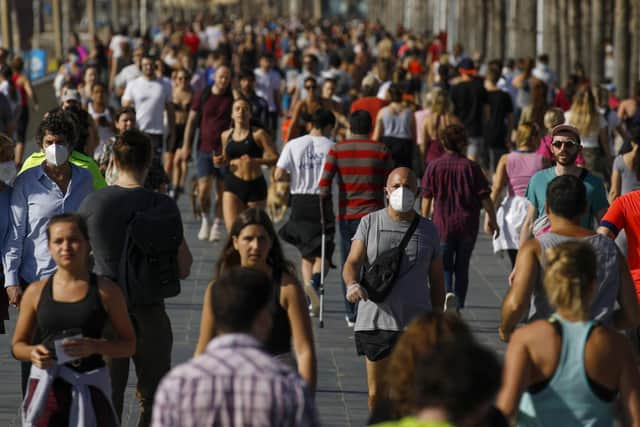Alex Kane: Now for the hard part – transitioning to the new ‘normal’


At the beginning of the crisis the projected death rate was enormous. Enormous enough to make it fairly easy to persuade businesses to close down, flights to remain grounded, schools and universities to shut until the autumn and millions of people to stay inside for ‘however long it takes’.
And for the first few weeks a combination of novelty and surprisingly good weather, along with promises from the government to pay salaries and pick up the other tabs, was enough to fuel a sense of calm and reassurance.
Advertisement
Hide AdAdvertisement
Hide AdBut within a couple of weeks it was becoming obvious that prolonged confinement was taking a huge physical and psychological toll. Most of us live in an average-sized house with an average-sized garden; fine and dandy for most of the time, yet claustrophobically small when the entire family is stuck in them 24/7.


Social media, Skype, mobile phones, TV box-sets, Netflix and computer games provided distraction at the start of the lockdown; but when distraction becomes the norm it raises all sorts of other problems. Those distractions were the go-to for previous periods of boredom, but what do we do when even the distractions have become boring?
Other worries also begin to set in. We all need space and we all need down-time. When we are denied them then anger and irritation take hold. Usually healthy relationships are put under tremendous stress. Adults grow increasingly concerned about their jobs. University students miss their life away from home. Younger children miss their school friends. All of them miss other aspects of their life which used to be taken for granted.
Bundle all of that stress into one package in a small house and you can understand why mental health experts believe that millions of us are dealing with real anguish right now – and unable to find an outlet for it.
Advertisement
Hide AdAdvertisement
Hide AdThat’s why governments are desperately trying to find a way of allowing people outside again as soon as is possible. The paradox they are dealing with is a particularly difficult one. The death rate is much lower than originally predicted, so people are asking why they are still confined to home. But if you let too many people out, too soon, those death rates could soar. Yet if you continue to keep people indoors and most businesses remain closed then the chances of economic collapse (along with massive unemployment) also soar. So, what does a government do?
Most of them seem to be opting for the bit-by-bit approach, with each new bit depending on the success of the bit that preceded it. A few days ago Leo Varadkar set out a timetable for easing the lockdown in the Republic and Boris Johnson is making a similar announcement later this week for the United Kingdom. But Varadkar’s proposals are still quite cautious and even if all goes according to plan some of the restrictions associated with lockdown and social distancing will remain in place for an unspecified period.
That’s because all governments are terrified of a ‘second wave’ in a few months time; because they know that once you ease restrictions and allow people to ‘return to normal’ complacency will set in. Which means that the mask will, quite literally, slip. A few weeks ago the vast majority of us were either terrified or, at the very least, genuinely concerned about the risks associated with CV-19. We believed it could kill us or seriously debilitate us. No surprise, then, that we hid from it and did what was necessary to avoid coming into contact with it.
I’m pretty sure the majority is no longer terrified by it; indeed most people are probably no longer even genuinely concerned by it. We don’t fear it anymore and we don’t feel the need to hide from it. So being told that it could be still be weeks before most of us are allowed to return to something resembling normal (I think Varadkar’s five stages are broken into three-week phases, which may be lengthened if a stage doesn’t work out as planned) is going to be a very hard sell.
Advertisement
Hide AdAdvertisement
Hide AdThe other key problem governments face is what they do if the bit-by-bit approach fails and the second wave still comes in a few months time – threatening to overwhelm health services, forcing businesses to close again and requiring millions of us to accept a lockdown which may be even more restrictive than the present one (not forgetting that it could be during the longer, colder, darker days of autumn/winter).
There is a lot to be said for building hope and providing people with a light at the end of the tunnel. But false hope, built on maybes, is a dangerous path to tread. Making it easier for people to leave their homes for longer periods is important, but should not be done until there is a very clear strategy for mass testing and monitoring. Also, we need fairly cast-iron guarantees that complacency can be controlled, social distancing enforced and restrictions reimposed very quickly if necessary.
Three other problems: there still isn’t a vaccine ready to roll out; there is no certainty that once you’ve had Covid-19 you won’t get it again; and, so far, there is no guarantee that a second wave is actually avoidable.
One thing we do know, though: it will still be a long time before we can talk of life being ‘normal’ again. Personally, I think what we’ve learned from this experience means that the old ‘normal’ has gone and we’ll learn to live with a new ‘normal’. Which, to be honest, is maybe no bad thing.